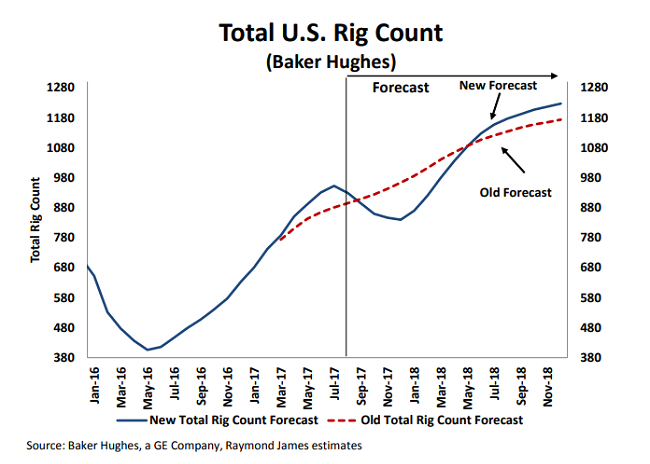According to Baker Hughes data, the overall US Oil & Gas drilling rig count has declined for the fourth straight week and the sixth time in 9 weeks, reversing the drilling uptrend that lasted from the week ending May 27, 2016 through July 28 this year.
During the week ended August 25, the active US rigs dropped 6 units to 940, down 18 units over the past 4 weeks. This drilling cycle reached its peak of 958 working rigs during the week ended July 28, which was up 536 units from its bottom in May 2016. This past week, oil-directed rigs pulled down the overall count with a 4-unit decrease to 759, which is a decrease of 9 rigs in two weeks.
A week ago, Raymond James & Associates reported that it expects about a 100-unit decline in the overall US rig count in the coming months before an oil price-driven drilling uptrend commences in 2018. The July 2017 peak drilling in the US is not expected to be reached again until about March or April 2018 after bottoming out this December.

The new RJA forecast followed the announcement from several major US exploration and production firms of reduced 2017 capital budgets and revised second-half drilling plans. RJA expects “a short-term rig count retracement” given the typical 15-20 weeks between a major shift in West Texas Intermediate prices and a response in rig counts. Another factor, says RJA, is that oil and gas exploration and production companies have been “substantially” outspending cash flows this year, which is unsustainable without either reduced drilling spending or higher oil prices.
RJA stands by their forecast of $65/bbl WTIC in the next 12 months, which is a number that I believe will fall in the lower end of a range between $65 and $75, possibly higher during a brief price spike at the cycle top, probably within six months.
Clearly this is simply guesswork; however, the fact is that US drilling is on the decline and will continue to do so until prices rise into the 60’s that is needed to sustain the financial health of this industry.

